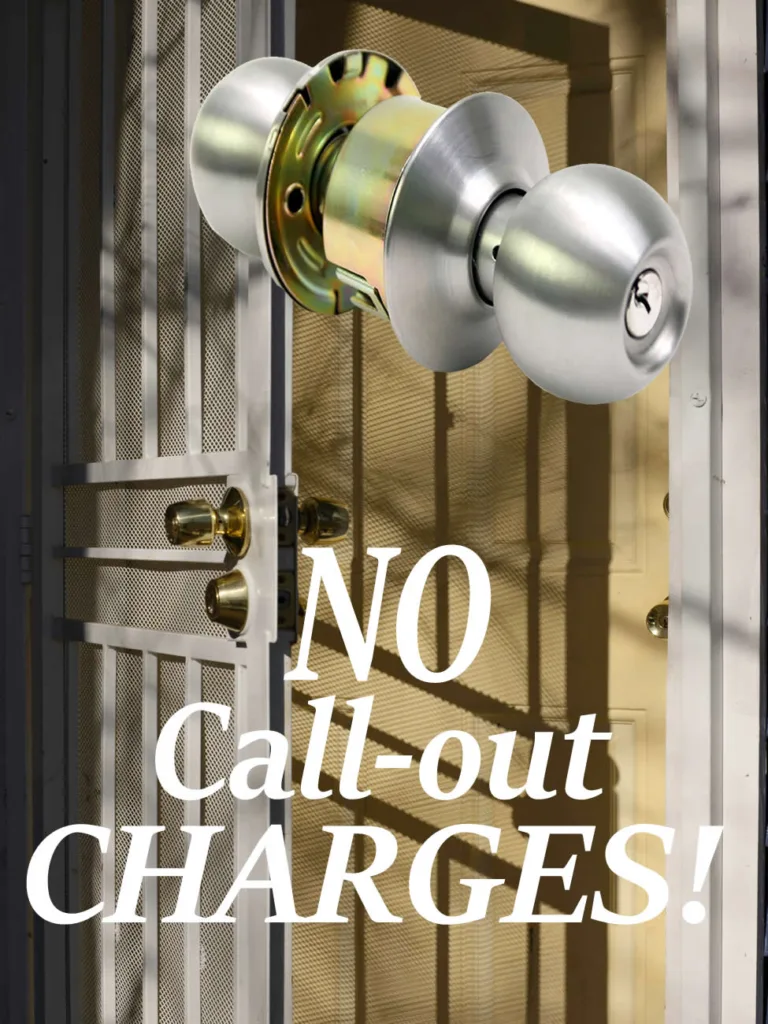Service Centres: Beaconsfield, High Wycombe, Aylesbury, Amersham, Hemel Hempstead, Bletchley, Newport Pagnell
Fast Locksmith Buckinghamshire County Services offers a modern professional approach, solving and delivering a first-rate service to our customers. We compete on quality and best practices. No hidden charges, and no callout fees. Local locksmith near me.
- Lockouts,
- Broken & lost keys,
- Locks upgrade,
- Sash-locks,
- Post burglary repairs,
- Euro locks,
- Internal locks,
- Anti snap locks,
- Deadbolt locks,
- Cylinder locks,
- Mortise Locks,
- High security locks,
- Smart locks,
- Keypad locks,
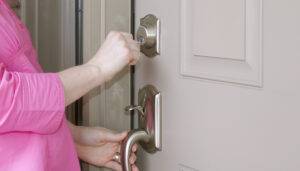 Fast Locksmith Buckinghamshire County Services offers high-quality repairs and 100% guarantees on every job we carry out, with no call-out charges. While our locksmith visits your home, you can use the opportunity to seek advice on other security-related matters which they will be happy to assist with.
Fast Locksmith Buckinghamshire County Services offers high-quality repairs and 100% guarantees on every job we carry out, with no call-out charges. While our locksmith visits your home, you can use the opportunity to seek advice on other security-related matters which they will be happy to assist with.
- We service:
- wooden doors,
- uPVC doors,
- uPVC windows,
- glass doors,
- metal doors,
- internal doors,
- security doors,
- intercom systems,
- smart home,
- coded number locks,
- CCTV,
- gate locks,
- garage doors locks,
- door adjustment & realignment,
- Local locksmith
All of the above and more…
 At Fast Locksmith Buckinghamshire County Services, ensuring the security of your home is a top priority for us. If you find yourself concerned about the adequacy of your home security against potential intruders, get in touch with us today. Our range of locksmith services tailored for residential purposes at Fast Locksmith Services is available. Whenever you require an enhancement in your home security or locks replacement, consider us your first choice. Our services are available around the clock, ensuring that if a break-in ever compromises your home, we can promptly take action to secure the premises. Fast Locksmith provides competitively priced services that cater to various needs and budgets, all while ensuring your complete satisfaction.
At Fast Locksmith Buckinghamshire County Services, ensuring the security of your home is a top priority for us. If you find yourself concerned about the adequacy of your home security against potential intruders, get in touch with us today. Our range of locksmith services tailored for residential purposes at Fast Locksmith Services is available. Whenever you require an enhancement in your home security or locks replacement, consider us your first choice. Our services are available around the clock, ensuring that if a break-in ever compromises your home, we can promptly take action to secure the premises. Fast Locksmith provides competitively priced services that cater to various needs and budgets, all while ensuring your complete satisfaction.
 Buckinghamshire, often abbreviated as Bucks, is a ceremonial county situated in the southeastern region of England. It shares its borders with Northamptonshire to the north, Bedfordshire to the northeast, Hertfordshire to the east, Greater London to the southeast, Berkshire to the south, and Oxfordshire to the west. The most prominent city in Buckinghamshire is Milton Keynes, while the administrative centre is Aylesbury.
Buckinghamshire, often abbreviated as Bucks, is a ceremonial county situated in the southeastern region of England. It shares its borders with Northamptonshire to the north, Bedfordshire to the northeast, Hertfordshire to the east, Greater London to the southeast, Berkshire to the south, and Oxfordshire to the west. The most prominent city in Buckinghamshire is Milton Keynes, while the administrative centre is Aylesbury.
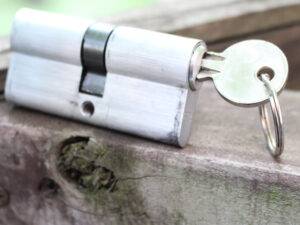 A locksmith is a professional who specialises in the installation, repair, and maintenance of locks and security systems. They are skilled in working with various types of locks, such as traditional key and tumbler, electronic, and combination locks.
A locksmith is a professional who specialises in the installation, repair, and maintenance of locks and security systems. They are skilled in working with various types of locks, such as traditional key and tumbler, electronic, and combination locks.
- Installing new locks and door hardware (Fresh Installation)
- Repairing damaged locks and keys
- Re-keying locks (changing locks so that they work with new keys)
- Providing emergency lockout services (such as when someone is locked out of their home or car) Normally on demand 24/7
- Post-burglary Repairs, securing forced doors and emergency repairs
 Locksmiths may also offer security assessments and recommendations to help clients improve the security of their homes or businesses. Some locksmiths may specialise in certain types of locks or security systems, such as high-security locks or access control systems.
Locksmiths may also offer security assessments and recommendations to help clients improve the security of their homes or businesses. Some locksmiths may specialise in certain types of locks or security systems, such as high-security locks or access control systems.
The mechanism used to identify the locks on uPVC doors involves lifting the handles and turning the key 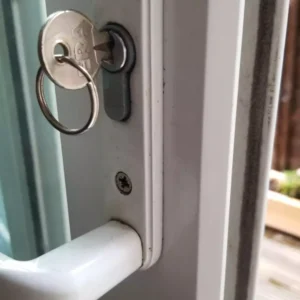 to secure them. These locks are commonly found on double-glazed doors and are now becoming popular on new composite doors as well. One notable advantage of these locks is that they secure the door to the frame in three different positions (top, bottom, and middle), in contrast to traditional locks that have only one position. However, maintaining these
to secure them. These locks are commonly found on double-glazed doors and are now becoming popular on new composite doors as well. One notable advantage of these locks is that they secure the door to the frame in three different positions (top, bottom, and middle), in contrast to traditional locks that have only one position. However, maintaining these locks can be more intricate and costly if a replacement becomes necessary. The lock itself resembles a Euro lock cylinder and can be easily substituted with anti-drill and anti-snap locks, which we recommend as a suitable replacement option.
locks can be more intricate and costly if a replacement becomes necessary. The lock itself resembles a Euro lock cylinder and can be easily substituted with anti-drill and anti-snap locks, which we recommend as a suitable replacement option.
If you encounter difficulty in lifting the handles when the door is closed, it usually indicates that the door is not properly shut or that the mechanism responsible for the locking process is misaligned with the frame. To prevent expensive repairs or potential security risks, we suggest contacting a qualified locksmith to examine the door and realign it with the frame. Our locksmiths are available for adjustments and maintenance of these locks, and you can conveniently book their services by calling our office number at 0800 707 4203.
Repairing an intercom system can vary widely depending on the specific issues you’re facing and the type of intercom system you have. Here’s a general guide to help you troubleshoot and 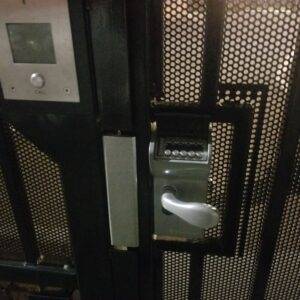 potentially repair common intercom system problems. Before attempting any repairs, identify the specific issue with your intercom system. Is it not powering on? Is the audio quality poor? Are certain units not communicating with each other? Pinpointing the problem will help you focus your troubleshooting efforts.
potentially repair common intercom system problems. Before attempting any repairs, identify the specific issue with your intercom system. Is it not powering on? Is the audio quality poor? Are certain units not communicating with each other? Pinpointing the problem will help you focus your troubleshooting efforts.
If the intercom system isn’t powering on, ensure that it’s receiving power. Check the power source, circuit breaker, and any fuses. Replace any blown fuses or reset tripped breakers. Make sure all cables and wires are properly connected. Loose or damaged connections can cause communication issues. Inspect cables for physical damage and replace them if necessary.
If you’re experiencing poor audio quality, ensure that the speakers and microphones are clean and not obstructed. Check for any frayed or damaged cables affecting audio transmission. If certain units aren’t communicating with each other, first make sure that they are powered on and connected properly. Check for any settings that might be blocking communication or causing interference.
Some modern intercom systems have digital components that can be configured through software settings. Check the user manual for guidance on how to adjust settings related to volume, channel, privacy modes, and more. Interference from other electronic devices can disrupt intercom communication. Ensure that there are no electronic devices nearby that could be causing interference. Try changing the channel or frequency to see if that improves communication. If possible, test the malfunctioning unit with a working unit. This can help determine if the issue lies with the specific unit or the entire system.
Video clip by Buckinghamshire Business First
A smart home is a house that uses various internet-connected devices and technologies to automate and remotely control household functions and services. This can include lighting, heating and cooling, security systems, entertainment systems, and appliances.
Smart homes are designed to make life easier, more convenient, and more efficient for homeowners by…
allowing them to control their home’s functions remotely using a smartphone or other internet-connected device. This can be done through a variety of technologies, such as voice commands, mobile apps, and remote controls.
Some examples of smart home devices and technologies include smart thermostats, which can automatically adjust the temperature of a home based on occupancy patterns and weather conditions, smart lighting systems, which can be controlled remotely and programmed to turn on and off automatically, and smart home security systems, which can alert homeowners to potential security threats and allow them to monitor their home’s security remotely.
Smart homes can also be integrated with other smart devices, such as virtual assistants like Amazon Alexa or Google Home, to allow for 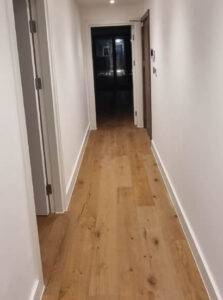 even greater control and automation of household functions. Overall, the goal of a smart home is to create a more comfortable, convenient, and efficient living environment for homeowners.
even greater control and automation of household functions. Overall, the goal of a smart home is to create a more comfortable, convenient, and efficient living environment for homeowners.
Repairs applied to a smart home can include:
- Network and Connectivity issues: If the smart home devices are not connecting to the internet, this can be caused by network issues such as poor Wi-Fi signals or issues with the internet service provider. These issues can be resolved by troubleshooting the network and connectivity settings of the devices and the home network.
- Software Updates: Smart home devices frequently receive software updates to improve their performance and security. If a device is not functioning properly, it may require a software update to resolve the issue.
- Hardware issues: Smart home devices can also experience hardware issues such as a malfunctioning sensor or a damaged power cable. These issues may require the replacement of the device or its components.
- Integration issues: Sometimes, the integration of smart home devices can cause issues. For instance, if a device is not communicating properly with other devices in the network, it may require reconfiguration or troubleshooting.
- Power supply issues: Smart home devices require a constant power supply to function correctly. If the power supply is interrupted, it can cause the devices to malfunction or stop working. In this case, the power supply issue needs to be addressed, and the devices may need to be reset.

